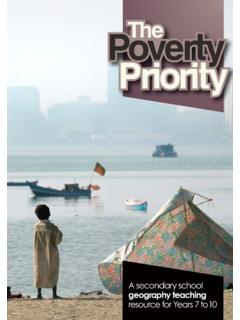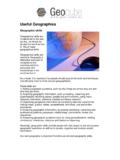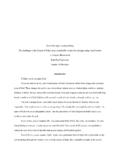Transcription of VF's all sustainability-ed materials V6
1 Teachers' Notes and Classroom Activities A resource for teaching Sustainable Development in Science, geography and Citizenship. For students aged 11 18. Understanding Sustainability Understanding Sustainability A resource for teaching Sustainable Development in Science, geography and Citizenship. For students aged 11 18. Teachers' Notes and Classroom Activities Contents Page Activities and curriculum links 1 Activities (DART activity) 4 Getting to school (sustainable transport) 7 Hybrid cars 11 Which is best natural or synthetic fabrics?
2 13 Life cycle analysis: strawberries from plant to plate 25 Life cycle analysis: wood or PVC window frames 31 Waste disposal: should we incinerate? 37 This resource can be downloaded from the web site. With the generous support of the Institute of materials , Metals and Mining, PVC division. 2007 Chemical Industry Education Centre, University of York. Cover photo courtesy of WHO . Understanding Sustainability Curriculum links 2 Understanding Sustainability Curriculum links Page 1 Curriculum Links *KS5 Citizenship / PSHE / Tutor period D & T KS3 KS4 KS3 KS4 KS3 KS4 KS5 KS3 KS4 KS3 KS4 KS5 KS3 KS4 KS5 Citizenship KS3 KS4 KS5* KS3 KS4 KS5* KS3 KS4 KS5 geography KS4 KS3 KS4 KS3 KS4 KS4 KS5 KS3 KS4 KS5 KS3 KS4 KS5 Science KS4 KS3 KS4 KS3 KS4 KS3 KS4 KS4 KS5 25 KS3 KS4 KS5 Summary Directed activity using to answer questions on sustainable development.
3 Introduces concepts of sustainable development by looking at transport used to get to school. Students research and produce a sales brochure or advert to describe how a hybrid car works. Practical investigations to test the physical properties of cotton compared to polyester. Context is choosing fabric for outdoor coat. Life cycle analysis of information on the production and use of cotton and polyester. Students look at strawberries from three sources: imported, UK grown and local pick your own. Decide which is the most sustainable. Students look at the sustainability of window frames made from wood and from PVC. Groups make presentations for and against the building of a waste incinerator. Page 4 7 11 13 20 31 37 Activity Sustainability questions Getting to school (sustainable transport) Hybrid cars Which is best natural or synthetic?
4 Life cycle analysis: strawberries from plant to plate Life cycle analysis: wood or PVC window frames Waste disposal: should we incinerate? Curriculum links 2 Understanding Sustainability Curriculum links Page 2 Sustainable development in the curriculum is a web site that can contribute to the teaching of sustainable development and understanding ideas in the Science GCSE curriculum. It is also ideal for exploring issues in sustainable development in geography GCSE. The tables summarise current National Curriculum links with Science Key stage 3 Sc2 5a About ways in which living things and the environment can be protected, and the importance of sustainable development Sc3 2i About possible effects of burning fossil fuels on the environment and how these effects can be minimised.
5 Key stage 4 Sc1 1d To consider the power and limitations of science in addressing industrial, social and environmental questions, including the kinds of questions science can and cannot answer, uncertainties in scientific knowledge, and the ethical issues involved. Sc2 4b/5b How the impact of humans on the environment depends on social and economic factors, including population size, industrial processes and levels of consumption and waste. Sc2 4c/5c About the importance of sustainable development. geography Key stage 3 1e Appreciate how people's values and attitudes, including their own, affect contemporary social, environmental, economic and political issues, and to clarify and develop their own values and attitudes about such issues 3a The location of places and environments studied.
6 Places and environments in the news and other a significant places and environments. 3e To explain how places are interdependent. 5b Explore the idea of sustainable development and recognise its implications for people, places and environments and for their own lives. 6f Population distribution and change. 6i Development. 6j Environmental Issues. 6k Resource Issues. Curriculum links 3 Understanding Sustainability Curriculum links Page 3 Citizenship Key stage 3 1i The world as a global community, and the political, economic, environmental and social implications of this, and the role of the European Union, the Commonwealth and the United Nations.
7 3c Reflect on the process of participating. Key stage 4 1f The opportunities for individuals and voluntary groups to bring about social change locally, in Europe and internationally. 1h The rights and responsibilities of consumers, employers and employees. 1j The wider issues and challenges of global interdependence and responsibility, including sustainable development and Local Agenda 21. 2c Contribute to group and exploratory class discussions, and take part in formal debates. Design and Technology Key stage 3 1c develop criteria for their designs to guide their thinking and to form a basis for evaluation 3c identify and use criteria to judge the quality of other people's products, including the extent to which they meet a clear need, their fitness for purpose, whether resources have been used appropriately, and their impact beyond the purpose for which they were designed [for example, the global, environmental impact of products and assessment for sustainability].
8 Key stage 4 1b consider issues that affect their planning [for example, the needs and values of a range of users; moral, economic, social, cultural and environmental considerations; product maintenance; safety; the degree of accuracy needed in production] 3c ensure that their products are of a suitable quality for intended users [for example, how well products meet a range of considerations such as moral, cultural and environmental] and suggest modifications that would improve their performance if necessary Teacher notes 1 Understanding Sustainability DART Activity Page 4 Sustainable development questions Students use the web site to answer questions relating to sustainable development (30minutes). It can be given as class work or as a homework if access to the internet is available.
9 Level: KS4 Questions assess students understanding of sustainable development / ability to gather information from the web site. Resources Access to Work sheet SD questions (attached below) Answers to questions 1 - Write down a definition for sustainable development. There are several definitions. The web site lists: Brundtland report (World Commission on Environment and Development) "Sustainable development is development that meets the needs of the present without compromising the ability of future generations to meet their own needs". Forum for the Future "Sustainable development is a dynamic process which enables all people to realise their potential and to improve their quality of life in ways which simultaneously protect and enhance the Earth's life support systems".
10 2a - Explain what is meant by social sustainability. Addresses the needs (and to a lesser extent the wants) of people. Things like ensuring access to education, healthcare, housing, food, clean drinking water etc. Could also mention aspects such as convenience and affordability. if public transport is too expensive for people, then it is not socially sustainable (nor is it economically sustainable also). Teacher notes 2 Understanding Sustainability DART Activity Page 5 2b - Explain what is meant by economic sustainability. Looks at the generation of wealth for individuals, businesses and also nations. This wealth then allows social and economic aspects to be addressed. For example, the creation of jobs will allow people to improve their lifestyles and, in the most severe cases, release them from poverty.




